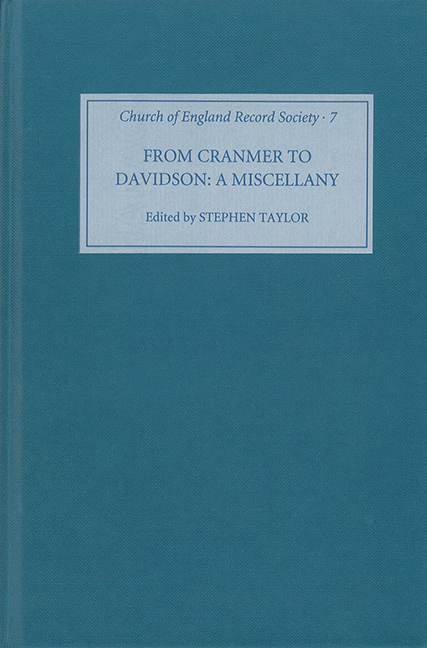Book contents
- Frontmatter
- Dedication
- Contents
- Preface
- Abbreviations
- 1 Thomas Cranmer and the Metropolitical Visitation of Canterbury Province 1533-1535
- 2 Edward Brocklesby: ‘The First Put Out of his Living for the Surplice’
- 3 Richard Montagu: ‘Concerning Recusancie of Communion with the Church of England’
- 4 Petitions for Episcopacy and the Book of Common Prayer on the Eve of the Civil war 1641-1642
- 5 Bishop Edmund Gibson's Proposals for Church Reform
- 6 Samuel Horsley: ‘Thoughts on Civil Government’
- 7 W. J. Conybeare: ‘Church Parties’
- 8 Randall Davidson: A Partial Retrospective
- Index
- Church of England Record Society: COUNCIL AND OFFICERS FOR THE YEAR 1998-99
5 - Bishop Edmund Gibson's Proposals for Church Reform
Published online by Cambridge University Press: 14 August 2020
- Frontmatter
- Dedication
- Contents
- Preface
- Abbreviations
- 1 Thomas Cranmer and the Metropolitical Visitation of Canterbury Province 1533-1535
- 2 Edward Brocklesby: ‘The First Put Out of his Living for the Surplice’
- 3 Richard Montagu: ‘Concerning Recusancie of Communion with the Church of England’
- 4 Petitions for Episcopacy and the Book of Common Prayer on the Eve of the Civil war 1641-1642
- 5 Bishop Edmund Gibson's Proposals for Church Reform
- 6 Samuel Horsley: ‘Thoughts on Civil Government’
- 7 W. J. Conybeare: ‘Church Parties’
- 8 Randall Davidson: A Partial Retrospective
- Index
- Church of England Record Society: COUNCIL AND OFFICERS FOR THE YEAR 1998-99
Summary
Introduction
In the study of the eighteenth-century church what has been called ‘the reform perspective’ - that is, the examination of the work of an institution in the light of subsequent legislative changes - has been under attack for some years. As long ago as 1934 Norman Sykes urged that the Georgian church should not be judged by anachronistic nineteenth-century standards. Despite his plea, much that has subsequently been written about the subject has continued to adopt the assumptions and perspectives of tractarians, evangelicals and other nineteenth-century church reformers. In recent years, however, the work of revision has begun to win wider acceptance. Optimists and pessimists can both still find evidence to support their judgments about the state of the church, but scholarly attention has increasingly concentrated on examining what were the preoccupations of the clergy, what they believed their role to be and what was the quality of the pastoral care which they provided. As questions such as these have been discussed, it has become more and more difficult to support any longer the view of the eighteenth-century church, handed down to us from the nineteenth century, as merely apathetic, lethargic and negligent.
Surprisingly, perhaps, church reform has received relatively little attention from revisionist historians and our conceptualization of this subject still owes much to ‘the reform perspective'. It is not difficult to see why this is the case. At first sight eighteenth-century church reform appears to be a non-subject. No significant measure of reform reached the statute book between the accession of George I and the end of the eighteenth century, and after 1717 convocation did not meet to do business until its revival in 1852. Thus, the eighteenth century is portrayed as an interlude between two vigorous movements of reform. The earlier of these, the ‘second church reform movement', dominated the decades immediately after the revolution of 1688 and had as its greatest, almost its only, achievement the establishment of Queen Anne's Bounty in 1704. The ‘third church reform movement’ had its origins in the early years of the nineteenth century and reached fruition in the work of the ecclesiastical commissioners in the 1830s.
- Type
- Chapter
- Information
- From Cranmer to DavidsonA Church of England Miscellany, pp. 169 - 202Publisher: Boydell & BrewerPrint publication year: 1999



